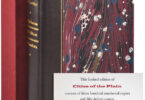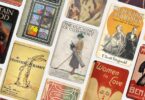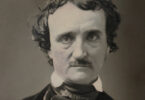
Maxfield Parrish “Stars”
Maxfield Parrish was a painter and illustrator whose works are well known for his neo-classical style, and his use of deeply saturated color. His unique style of painting helped to shape America’s Golden Age of illustration.
He was born as Frederick Parrish on July 25, 1870, in Philadelphia, Pennsylvania, but later borrowed his grandmother’s maiden name of Maxfield for his professional moniker. His father, Stephen Parrish, was a landscape painter and engraver who encouraged his son to embrace art from a young age. Maxfield studied arts and architecture at Haverford College, the Pennsylvania Academy of the Fine Arts, and Drexel Institute of Art.
In 1897, Parrish’s professional career began as he was commissioned to illustrate Kenneth Grahame’s “The Walls Were as of Jasper” for the August issue of Scribners Magazine. The same year saw his work in L. Frank Baum’s “Mother Goose in Prose.” He illustrated two more of Grahame’s books, Dream Days and The Golden Age, in 1899 & 1900.

Maxfield Parrish “Reveries”
Most of his published work at this time was done in black and white rather than the sensual riot of color that was to become the hallmark of his style.
In 1900, Parrish fell ill with tuberculosis and found himself weakened and suffered a nervous breakdown. The dry air of the desert was prescribed for his recovery, and Parrish found himself convalescing in Arizona. While there, he was commissioned to paint the colorful desert landscapes, a shift which caused him to shift directions from illustrations to oil painting.
His brilliantly colorful oil paintings were luminous and magical, and quickly became immensely popular. Magazines such as Hearst’s, Colliers, and Life commissioned him regularly, and advertisers were clamoring for his attention. Parrish kept busy providing images for more books through the 1920’s: Eugene Field’s Poems of Childhood (1904), Arabian Nights (1909), A Wonder Book and Tanglewood Tales (1910), The Golden Treasury of Songs and Lyrics (1911) and The Knave of Hearts (1925). By the end of the twenties, Parrish was ready to retire from professional illustration and create art for it’s own sake.
Parrish was certainly famous for the dazzling, rich saturation of hues that marked much of his artwork, and in acknowledgment, the shade “Parrish blue” was coined. To achieve the unique lighting effects that marked his works, Parrish would painstakingly apply layer after layer of thin, transparent oil and varnish over a blue and white monochromatic under-painting.
He also revolutionized certain techniques in creating depth in his paintings using enlarged photographs of his models projected and traced, then cut out, and glazed into the main piece.
In 1931, Parrish declared to the Associated Press, “I’m done with girls on rocks! I’ve painted them for thirteen years and I could paint them and sell them for thirteen more. That’s the peril of the commercial art game. It tempts a man to repeat himself. it’s an awful thing to get to be a rubber stamp. I’m quitting my rut now while I’m still able.” He dedicated himself to painting landscapes until he retired in 1960. He lived comfortably on his royalties until he died in his home in 1966, at age 95.
“Maxfield Parrish was certainly one of our most prominent illustrators and hardly a home in America existed that didn’t have a Maxfield Parrish print. I’m an illustrator. Maxfield Parrish was a painter-illustrator. He was in the Golden Age of Illustration. When I was in art school I admired him. He was one of my gods.” – Norman Rockwell








i was wandering if Maxfeild Parrish prints are for sell or a place I can find them email me if you can please much appreciated thanks